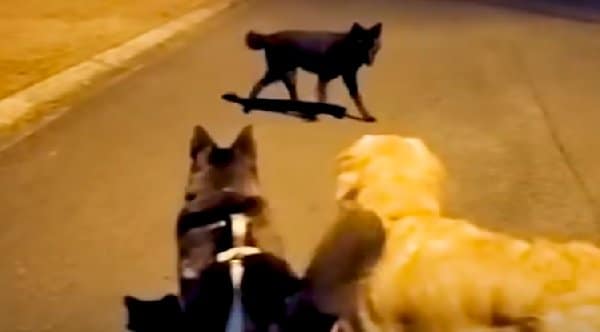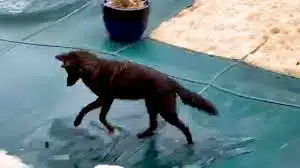In a heartwarming video, a coyote named Carmine is rescued from urban streets where it had been spotted playing with domestic dogs and appearing on people’s back porches. Multiple calls from concerned citizens led to Carmine’s capture by a wildlife management team. The coyote, always seen alone, was suspected to have been ousted by its pack or possibly hand-raised. Captured calmly in a trap, Carmine was transferred to Yellow River Wildlife Sanctuary for safety and quarantine. Here, Carmine meets another coyote named Wilee.

Wilee, also a resident of the sanctuary, had been confiscated and brought to the sanctuary earlier. The sanctuary staff believed that Carmine and Wilee could potentially be good companions for each other. However, there was initial uncertainty about how well they would get along, considering Carmine more wild nature and the fact that coyotes can have complex social behaviors.
To facilitate a safe and gradual introduction, Carmine and Wilee were first placed in adjacent enclosures where they could see and smell each other without direct contact. This careful approach allowed them to become accustomed to one another’s presence. After about two days of this indirect interaction, the door between their enclosures was opened.
The moment they were allowed to meet directly was a remarkable one. The video captures the joy and excitement as Carmine and Wilee interact, play, and explore their surroundings together. It was clear that they hit it off well, indicating the beginning of a strong companionship.
This successful pairing of Carmine and Wilee at the sanctuary not only provided each coyote with a much-needed companion but also highlighted the importance of wildlife sanctuaries in offering safe havens and social opportunities for rescued animals.
Coyotes: Solitary or Social Creatures?
Coyotes, scientifically known as Canis latrans, are medium-sized members of the dog family. They are known for their adaptability to various habitats, including urban environments. Coyotes typically weigh between 25-35 pounds and have a grayish-brown coat with reddish tinges. They are often mistaken for domestic dogs but can be distinguished by their bushy tail and yellow eyes.
Pack Dynamics and Social Structure
Coyotes are known for their complex social structures, which include living in packs or as solitary animals. Packs usually consist of an alpha male and female pair and their offspring. These family groups defend territories against other coyotes, marking their areas with urine and feces. Coyotes use a variety of vocalizations for communication within the pack and to signal territory to outsiders.
Diet and Habitat
Coyotes are opportunistic feeders and primarily consume small rodents, fruit, and occasionally larger prey like deer. In urban areas, they adapt to available food sources, including garbage and pets, if necessary. Coyotes prefer open areas like prairies and deserts but can thrive in wooded patches and shrubbery within cities.
Breeding and Lifespan
Coyotes typically mate in February, with the alpha pair being the primary breeders. Females give birth after a gestation period of about 62-65 days, usually in dens. Litter sizes vary, but coyotes can adjust their litter size based on food availability and population density. They are known for their monogamous behavior, often forming long-term pair bonds. In most cases, both members of a breeding pair work together to defend their territory against other coyotes. In the wild, most coyotes live up to 6-8 years, with deaths often caused by human activities or diseases like mange.
Conservation and Coexistence
Coyotes play a vital role in controlling rodent populations and maintaining ecological balance. However, their presence in urban areas can lead to conflicts with humans. Effective management strategies and public education are essential for peaceful coexistence between coyotes and human communities.
You might also enjoy:
The Surprising Link Between Acorn Worms and Climate Stability
Watch: The Incredible Shape-Shifting Mimic Octopus
The Small Sharks of South Africa’s Underwater Kelp Forests
Join our Forum for free today!

- The Bond Between a Wild Baby Bison and Her Rescuer - July 20, 2024
- An Excited Husky’s First Ever Time in Snow - July 20, 2024
- Top 20 Colorful Species To Brighten Your Day - July 14, 2024


